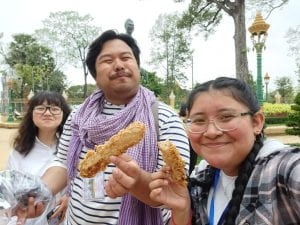 It is January 10, and we are starting the day off with a quick breakfast at the hotel we were staying at. Our class soon got on to the bus to head further into Siem Reap. Today we focused more on the Niak Ta, or the local spirits that reside in various parts of Cambodia. We took a local tour with our guide who was referred by researcher Tim Frewer. It is important to note that the Niak Ta is considered powerful and taken seriously in Cambodia as locals tell tales of their experiences with the local spirit in their village. But before we get into it, here is a cool fun fact about a hotel in Siem Reap!
It is January 10, and we are starting the day off with a quick breakfast at the hotel we were staying at. Our class soon got on to the bus to head further into Siem Reap. Today we focused more on the Niak Ta, or the local spirits that reside in various parts of Cambodia. We took a local tour with our guide who was referred by researcher Tim Frewer. It is important to note that the Niak Ta is considered powerful and taken seriously in Cambodia as locals tell tales of their experiences with the local spirit in their village. But before we get into it, here is a cool fun fact about a hotel in Siem Reap!
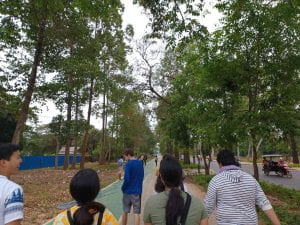
According to our tour guide, the hotel, Grand Hotel D’Angkor is the oldest hotel in Siem Reap and room costs can go well over a thousand dollars per night!
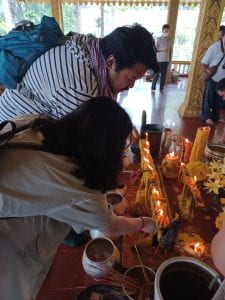
Going back to the Niak Tas, it is important to highlight that these beliefs are different from Angkor, Hinduism and Buddhism, but they do have some slight parallels. As we walked around the town, we came across a small market across the street from the Royal Residence, where the King would stay during his visits to Siem Reap. The local tour guide informed us that often lotuses and incense are used at shrines. Some of the vendors also sold birds, and the guide told us that releasing birds is like releasing bad luck. When talking about beliefs and spirituality, the guide brought up how Buddhism and Hinduism are often interconnected and combined together. We then learned about Preah Ang Chak Preah Ang Chorm, two princesses’ statues that reside in the Royal Residence. They are seen as the local Niak Ta and incredibly powerful. After he finished talking about how the locals gave offerings to the statues, the class also wanted to participate.
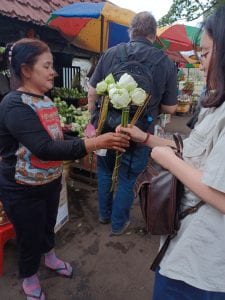 We went to the vendors where a couple of my classmates got lotus flowers and incense. The class burnt the incense and gave the lotus flowers as offerings to the statues. Many people came to the shrine to give their offerings in return for a prayer or wish to be granted. Offerings included flowers, money, water, soft drinks, candy, and there was even a whole roasted pig. Our guide has told us that the most likely reason why there was a roasted pig was because someone’s goal or prayer was heard. We were also told that when people are traveling to other parts of Cambodia and they are going through Siem Reap, they need to pray at the shrines to wish for good luck on their travels or else bad things could happen along the way.
We went to the vendors where a couple of my classmates got lotus flowers and incense. The class burnt the incense and gave the lotus flowers as offerings to the statues. Many people came to the shrine to give their offerings in return for a prayer or wish to be granted. Offerings included flowers, money, water, soft drinks, candy, and there was even a whole roasted pig. Our guide has told us that the most likely reason why there was a roasted pig was because someone’s goal or prayer was heard. We were also told that when people are traveling to other parts of Cambodia and they are going through Siem Reap, they need to pray at the shrines to wish for good luck on their travels or else bad things could happen along the way.
After our visit to the royal residence, we went to other parts of Siem Reap. We then visited a house that belonged to Dap Chhoun. He was a general that betrayed the King by working with the CIA, King Sihanouk The statues are seen as Niak Ta, and their story goes farther beyond from the Royal Residence. How did they get to the Royal Residence? To figure out their origins, we would have to go back to ancient Angkor times. 
Preah Ang Chak and Preah Ang Chorm were built and placed in Angkor Wat. They represent two princesses who were alive during Angkor, and they remained there until they were taken by someone else and then placed into the forest. It was then we learned about warlord general Dap Chhuon, who was the general of Siem Reap back in the 1950s. It was said that he gained a lot of powers and would spend at least half an hour a day, to Preah Ang Chak Preah Ang Chorm. This part of Cambodian history is what led to so many locals giving offerings and praying to the sister statues. This would not be the first time we will hear about Dap Chhuon and the local Niak Tas.
After our tour with the guide, we spent the other part of class with Tim Frewer. We learned about the relocation sites that the Khmer people living by Angkor, are being sent to. The first of the Khmer people that were sent there were the people who used to live by the Siem Reap River. People’s homes are being taken down and roughly six to seven thousand families are being relocated. This began 10 to 20 years ago when people were building houses along the Siem Reap River. We talked to two women who were among the first to be relocated, and they told us that the people who lived on the land, before they moved there, asked the local Niak Ta, also known as Arleaksor, to place a curse on the land that the government took from them to give to those being relocated. Because of this, people now give offerings to the Niak Ta and ask for protection and to not be cursed by the Niak Ta. Those that are being relocated are given a plot of land that is 20 meters by 30 meters of land, and though it may not be a lot, the government originally didn’t even want to give them land in the first place.
Both ladies help take care of the shrine, and they told us, every year, there would be a ceremony and there was a spirit medium who people can go to and ask questions to the Niak Ta. It is important to reiterate that one must be careful with what they say and do around the Niak Ta, as the spirit can bring harm.
As we learned more about the local spirit, one of the ladies told us that Dap Chhuon used to come to the Niak Ta and give offerings in exchange for asking help from the spirit. It is said that the Niak Ta favored him and that is why it is still seen as a powerful force. Parents would come to the local shrine and ask for their children to pass school with good grades and often people feel that the Niak Ta is on their side and helps them with their prayers. Even people who play lottery will come and visit the Niak Ta and would ask for the winning numbers. Even before constructing a house in the relocation village, the people would ask for permission from the Niak Ta and would pray for prosperity.
The lady with the glasses would collect recycling and the other lady also did some recycling and cleaning. This type of work became inaccessible once they were relocated, but now their income mainly relies from looking after the shrines, where people on occasion would give them money. When they moved, they took whatever they had and transported their old homes. It took several months for them to build some sort of shelter, but for newcomers today, they are often given some rice and food, along with the plot of land, as compensation for relocating.
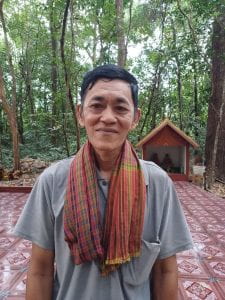
Soon after learning about the local Niek Ta in the relocation village, we went to the original site of Preah Ang Chak Preah Ang Chorm, in a jungle. There, we met Rith Thira, an older man who has seen the original statues of the princesses. He retold the story of the statues and also added more to what we learned from earlier in the day with the guide. The princesses would tell the King, where to go to for war, and what spots were ideal to plan an attack. However, the King JayaramanⅡ, was involved with a lot of bloodshed and the princesses were opposed of war. To oppose a war with the Cham, Preah Ang Chak and Preah Ang Chorm would talk to the wife of the King and told her to not go to war. The wife tried but to no avail, and when the King sent his first general to fight with the Cham, the Cham won and slaughtered the army. King Jayaraman Ⅱ still did not listen, so he sent his other general to fight with the Cham, and they also won that war and killed the army along with the general. This is why some statues of King Jayaraman Ⅱ depicts him missing both of his arms, because it represents him losing both of his generals.
 Thira would also tell us that, during the time of the Khmer Rouge, some of the soldiers and guards tricked the locals that they were going to relocate the statues to a safer place and needed to know how to move the original statues of Preah Ang Chap and Preah Ang Chorm. They asked because they tried everything to lift the statues, but nothing happened. When they did ceremonies and gave offerings, the Khmer Rouge were able to lift it. However, what they ended up doing was that they threw both statues into two different ponds. Thira was a mobile soldier when he saw it happened, and after the war, he prayed and gave offerings for prosperity to the statues. After doing so, he came across a high official with his people, while he was getting his hair cut and he overheard him and told them that he has seen where the original statues were.
Thira would also tell us that, during the time of the Khmer Rouge, some of the soldiers and guards tricked the locals that they were going to relocate the statues to a safer place and needed to know how to move the original statues of Preah Ang Chap and Preah Ang Chorm. They asked because they tried everything to lift the statues, but nothing happened. When they did ceremonies and gave offerings, the Khmer Rouge were able to lift it. However, what they ended up doing was that they threw both statues into two different ponds. Thira was a mobile soldier when he saw it happened, and after the war, he prayed and gave offerings for prosperity to the statues. After doing so, he came across a high official with his people, while he was getting his hair cut and he overheard him and told them that he has seen where the original statues were.
Eventually, as two statues were being moved to the Royal Residence, Thira noticed that the statues were replicas, and the originals were still out there. Apparently, they were taken by a plane. Rith Thira was one of the few that had a close connection with the original because he knew details that others do not, such as the statues have Sanskrit text on the back of them. The statues at the Royal Residence in Siem Reap today are replicas! No one truly knows where the originals are now. This is the end of day eight in CU in Cambodia program!